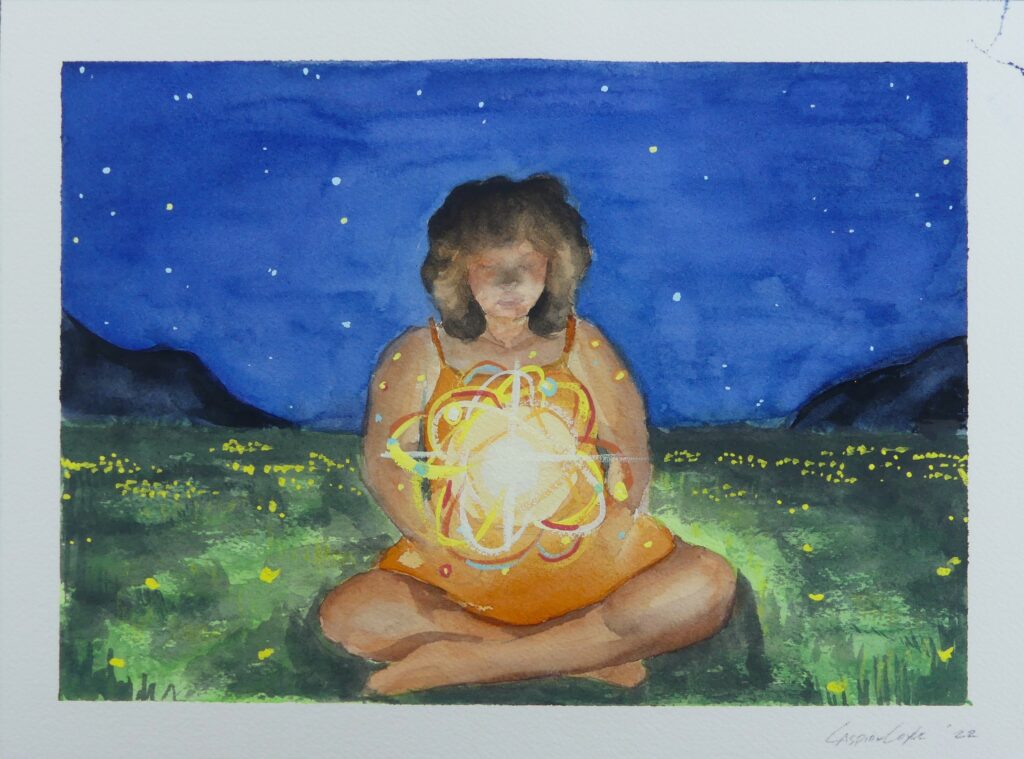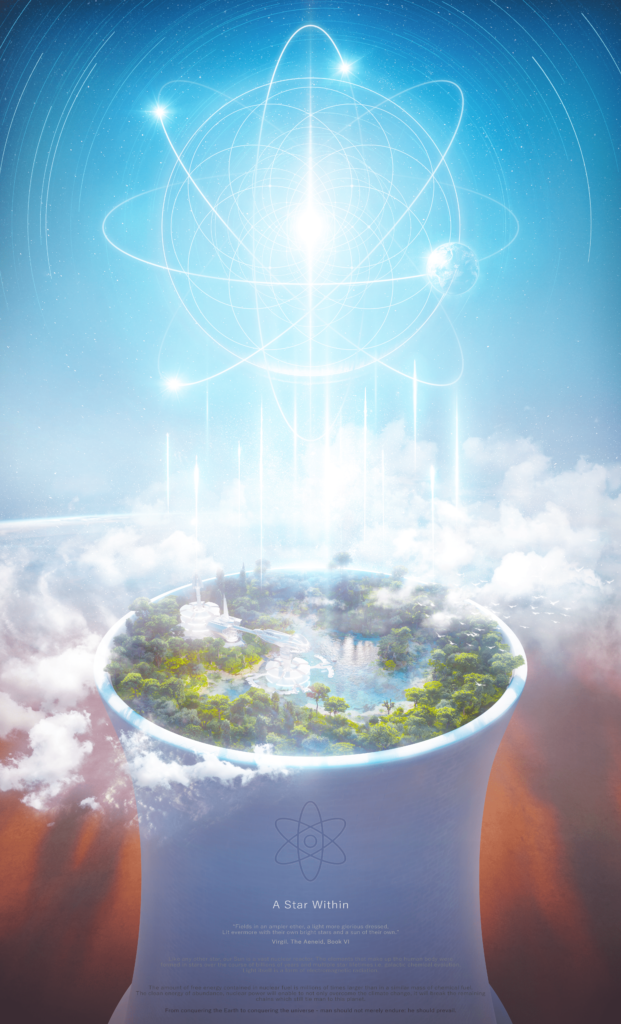Author: Kiersten Sundell

Generation Atomic’s 2022 Atomic Art Contest asked artists across the globe one thing: what does the future of nuclear power look like? In response, artists from 34 countries rose to the challenge and produced some of the most exceptional artwork that industry experts have ever seen. The contest featured judges such as artist Angel Rafael Vazquez-Concepcion, architecture specialist Anderson Inge, and nuclear influencer Isabelle Boemeke.
The inspiration for the contest came from the realization that a simple google image search for “nuclear energy” rendered dystopian depictions of oozing green slime or weaponry. Executive director of Generation Atomic Eric Meyer weighed in on the contest, noting that his team was tired of finding depictions of major catastrophes when the search query was as simple as “nuclear power plant.” “We thought, how can we flood this search engine with images of what nuclear power is truly about?”
The plan was simple: an art contest. Artists competed to win a first place prize of $5,000, and we spoke to the winners to learn how their artwork will help change the game for nuclear advocacy.
Caspian Coyle, the first place winner, is a transgender artist based in California, who describes themselves as being passionate about the intersections of creativity, magic, science, and philosophy. “I love to cultivate space in my life, and in the lives of those I love, for dreaming and creating,” Caspian notes.
Leonora Yakimashchenko, second place winner, is a professional artist based in Kyiv, Ukraine who graduated from the Ukrainian Academy of Arts (NAOMa). According to Leonora, much of the artwork she produces is a “dream,” inspired by what life outside of war will look like. [Translated from Ukrainian] “people are dying here, we are threatened with nuclear weapons, our power plants, which provide heat not only to Ukrainians, are disabled by the terrorist of the aggressor country. And we Ukrainians do not know whether the morning will come. On this note, I am interested in atomic energy as a means for a peaceful life — to give warmth and light, comfort to people.”
Vasily Gogidze, who came in at third place, is a professional architect from Tbilisi, Georgia, whose self-proclaimed (twenty-eight) interests include everything from music theory and neoclassical sculpture to nuclear physics, military aviation and evolutionary neurology. “With regards to nuclear power, I am attracted to atomic age design, high-tech aesthetics of modern microreactor power plants, and a wide range of possible nuclear energy implementations,” he explained.
Here’s more of what today’s most inspired nuclear artists had to say:
How has this art contest experience influenced your perception of nuclear power?
Vasily: Although I had a fairly good understanding of the technical side of nuclear energy generation, the scale of environmental, economic and other advantages was somewhat astonishing to realize. Nuclear power is much more sustainable than fossil fuels, and much more reliable than renewable energy sources such as wind or solar, I have realized. One could ask a rhetorical question: Would you give up fire because it poses some risks? The “new fire” is commonly used to describe nuclear power. Fire, and nuclear energy, are represented not only in physical terms and as a harnessing of nature, but also as a phenomenon symbolizing knowledge, scientific and technological progress, and anthropogenesis — the process of becoming human.

What made you interested in advocacy through art?
Caspian: I learned about nuclear power recently in college and was excited to learn more when I heard about this art contest. I was so filled with wonder and excitement to hear about a way to create energy sustainably. It’s easy to be overwhelmed by negative news when it comes to the environment so it was relieving and much-needed to learn about nuclear power’s potential. I really wanted to capture that sense of wonder and excitement I was feeling in the piece. I wanted to find a way to visually invite people in to feel what I was feeling.
How do you think nuclear power can help achieve global energy goals?
Leonora: Maybe, if we were to use atomic energy throughout the world, it would help us to solve many of the riddles in existence that we currently cannot solve. In a world where we struggled with finding enough energy to go around, an atom appeared in the hands of clever and kind people, not to harm us, but to save us.
Can you explain what your piece means and the thought behind it?
Caspian: This piece is about overcoming fear and moving towards a place of curiosity and wonder. At first I had wanted to paint a child holding the atom to symbolize the continued potential. But when my wonderful partner, Wyatt, took some reference photos of me to use I realized there was something powerful about me, a transgender person, holding the atom. I understand what it’s like to be stigmatized. Nuclear power isn’t something new like a child. It has its own history that has informed our perception of it, whether it is fair or not. So the piece just started coming together in a way that felt personal and meaningful to me.
How did your artistic career begin?
Leonora: Once, a long time ago, my father had built layouts for DOSAAF (a military training organization in the Soviet Union). Time passed, I rediscovered these layouts, and I used them as inspiration to begin drawing. Because of this, my first-ever artwork was born. Artwork made me think about how different forms of life were able to coexist with each other so easily, which is why I like it.

Why is art so important in influencing human perspective?
Vasily: Apart from appealing to reason, inspiring through the power of art should not be overlooked. We the nuclear power advocates have a Promethean mission of enlightenment. “Enlightenment is man’s emergence from his self-imposed immaturity” as Immanuel Kant defined is very much true to the infantile misconceptions and stereotypes surrounding atomic energy. We are the products of nuclear reactions in stars — over billions of years and numerous stellar lifetimes, the components that make up the human body were created in stars.
What do you hope to see in the future of nuclear power?
Caspian: I hope to see more societal acceptance of nuclear power. I hope to see continued progress in nuclear power as a sustainable energy source. I would love to see more states in the U.S. being run entirely by it and more global use of it.
In Closing
Generation Atomic hopes that the 2022 Atomic Art Contest is the first of many, as it has effectively provided a stage where independent artists can use their talents for radical good. The atomic artwork has been viewed by global audiences, and is helping to erase some of the implicit bias that still surrounds nuclear energy. “In the future, we’re hoping that images like these will show up when people search for nuclear energy,” Meyer says. “After decades of fear and misinformation, it’ll take a concerted effort to change the visual narrative. This project is an important step in doing that.”


